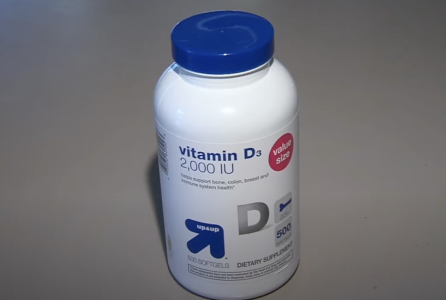Are you taking vitamin D at the wrong time? Experts reveal the secret to maximum absorption
- Replies 0
Disclaimer: The information provided in this article is for educational purposes only and is not intended as a substitute for professional medical advice, diagnosis, or treatment. Always consult your physician or other qualified healthcare providers with any questions you may have regarding a medical condition or before making any changes to your health regimen.
If you’ve ever found yourself standing in the supplement aisle, squinting at tiny print and wondering if you’re supposed to take your vitamin D with breakfast, lunch, or a midnight snack, you’re not alone.
Here at The GrayVine, we know that the “sunshine vitamin” is a hot topic—especially for those of us who remember when milk was delivered to the doorstep and sunscreen was optional.
But with so much conflicting advice out there, it’s time to set the record straight: When is the best time to take vitamin D for maximum absorption, and what else should you know to get the most out of your daily dose? Let’s shed some light on the subject (pun intended).
Why Vitamin D Matters—Especially as We Age
Vitamin D isn’t just another letter in the alphabet soup of supplements. It’s a powerhouse nutrient that supports your immune system, helps your body absorb calcium for strong bones, and keeps your muscles and nerves humming along.
As we get older, our bodies become less efficient at producing vitamin D from sunlight, and our dietary habits may change, making it even trickier to get enough.
Here’s the kicker: About 1 in 4 Americans are running low on vitamin D, and the risk only increases with age.
Why? Blame it on less time outdoors, more sunscreen (which blocks vitamin D production), and a diet that doesn’t always include enough vitamin D-rich foods like fatty fish, eggs, or fortified milk.

How Much Vitamin D Do You Really Need?
For most older adults, the recommended daily value is 20 micrograms (that’s 800 IU for those who like to keep score).
To put that in perspective, you’d need to eat a hefty serving of salmon or drink a quart of fortified milk every day to hit that target. Not exactly practical—or appealing—for most of us.
That’s why supplements are so popular. But before you pop that pill, let’s talk about how to make sure your body actually absorbs it.
Morning, Noon, or Night: Does Timing Matter?
Here’s the good news: According to leading dietitians and doctors, the time of day you take your vitamin D doesn’t make a significant difference in how well your body absorbs it.
Also read: Could this common vitamin help slow aging? Here’s what the research says
Whether you’re an early bird or a night owl, you can take your supplement whenever it fits best into your routine.
The real secret? Consistency. The best time to take vitamin D is the time you’ll remember to take it.
If you’re a creature of habit who always has breakfast at 8am, make it part of your morning ritual.
If you’re more likely to remember after dinner, that works too. The key is to link it to something you already do every day—like brushing your teeth or making your morning coffee.

The Fat Factor: Why What You Eat Matters More Than When
Here’s where things get interesting: Vitamin D is a fat-soluble vitamin, which means your body absorbs it best when you take it with a meal or snack that contains some healthy fat.
Think of it as a VIP guest that needs a little help getting through the door.
So, what counts as “healthy fat”? Here are some easy options:
- A slice of whole-grain toast with almond or peanut butter
- A handful of walnuts or pecans
- A salad drizzled with olive oil
- A glass of whole milk or a serving of full-fat yogurt
Related story: Dietitians reveal: Boost your vitamin D instantly with these 9 surprising superfoods!
If you’re in a rush, even a spoonful of nut butter or a few olives will do the trick. The important thing is not to take your vitamin D on an empty stomach or with a fat-free meal—otherwise, you might be missing out on its full benefits.
D2 vs. D3: Which Form Should You Choose?
Not all vitamin D supplements are created equal. There are two main types: D2 (ergocalciferol) and D3 (cholecalciferol).
D2 comes from plant sources and fortified foods, while D3 is found in animal products and is the form your body makes from sunlight.
Research shows that vitamin D3 is more effective at raising and maintaining your vitamin D levels. So, if you have a choice, opt for D3—unless your doctor recommends otherwise.
Source: WCNC / Youtube.
Who Needs to Be Extra Careful?
Some folks need to pay special attention to their vitamin D intake and absorption:
- People with digestive issues (like Crohn’s disease or after gastric bypass surgery)
- Those with osteoporosis or osteopenia
- Anyone with chronic kidney or liver disease
- People taking certain medications that affect vitamin D metabolism
If you fall into one of these categories, it’s especially important to work with your healthcare provider to find the right dose and timing for you.
What About Side Effects?
Vitamin D is generally safe, but more isn’t always better. Too much can lead to nausea, constipation, or even more serious issues like kidney stones. If you notice any unusual symptoms after starting a supplement, check in with your doctor.
Read next: Are you vitamin D deficient? Spot the signs and boost your levels fast!

Have you struggled to keep your vitamin D levels up? Do you have a clever way to remember your supplements, or a favorite vitamin D-rich recipe? Share your tips, questions, and stories in the comments below!
If you’ve ever found yourself standing in the supplement aisle, squinting at tiny print and wondering if you’re supposed to take your vitamin D with breakfast, lunch, or a midnight snack, you’re not alone.
Here at The GrayVine, we know that the “sunshine vitamin” is a hot topic—especially for those of us who remember when milk was delivered to the doorstep and sunscreen was optional.
But with so much conflicting advice out there, it’s time to set the record straight: When is the best time to take vitamin D for maximum absorption, and what else should you know to get the most out of your daily dose? Let’s shed some light on the subject (pun intended).
Why Vitamin D Matters—Especially as We Age
Vitamin D isn’t just another letter in the alphabet soup of supplements. It’s a powerhouse nutrient that supports your immune system, helps your body absorb calcium for strong bones, and keeps your muscles and nerves humming along.
As we get older, our bodies become less efficient at producing vitamin D from sunlight, and our dietary habits may change, making it even trickier to get enough.
Here’s the kicker: About 1 in 4 Americans are running low on vitamin D, and the risk only increases with age.
Why? Blame it on less time outdoors, more sunscreen (which blocks vitamin D production), and a diet that doesn’t always include enough vitamin D-rich foods like fatty fish, eggs, or fortified milk.

It doesn’t matter whether you take your vitamin D supplement in the morning or evening—the most important thing is to take it at a time you’ll remember regularly. Image source: WCNC / Youtube.
How Much Vitamin D Do You Really Need?
For most older adults, the recommended daily value is 20 micrograms (that’s 800 IU for those who like to keep score).
To put that in perspective, you’d need to eat a hefty serving of salmon or drink a quart of fortified milk every day to hit that target. Not exactly practical—or appealing—for most of us.
That’s why supplements are so popular. But before you pop that pill, let’s talk about how to make sure your body actually absorbs it.
Morning, Noon, or Night: Does Timing Matter?
Here’s the good news: According to leading dietitians and doctors, the time of day you take your vitamin D doesn’t make a significant difference in how well your body absorbs it.
Also read: Could this common vitamin help slow aging? Here’s what the research says
Whether you’re an early bird or a night owl, you can take your supplement whenever it fits best into your routine.
The real secret? Consistency. The best time to take vitamin D is the time you’ll remember to take it.
If you’re a creature of habit who always has breakfast at 8am, make it part of your morning ritual.
If you’re more likely to remember after dinner, that works too. The key is to link it to something you already do every day—like brushing your teeth or making your morning coffee.

Vitamin D is best absorbed when taken with a meal or snack containing healthy fats, as it’s a fat-soluble vitamin. Image source: WCNC / Youtube.
The Fat Factor: Why What You Eat Matters More Than When
Here’s where things get interesting: Vitamin D is a fat-soluble vitamin, which means your body absorbs it best when you take it with a meal or snack that contains some healthy fat.
Think of it as a VIP guest that needs a little help getting through the door.
So, what counts as “healthy fat”? Here are some easy options:
- A slice of whole-grain toast with almond or peanut butter
- A handful of walnuts or pecans
- A salad drizzled with olive oil
- A glass of whole milk or a serving of full-fat yogurt
Related story: Dietitians reveal: Boost your vitamin D instantly with these 9 surprising superfoods!
If you’re in a rush, even a spoonful of nut butter or a few olives will do the trick. The important thing is not to take your vitamin D on an empty stomach or with a fat-free meal—otherwise, you might be missing out on its full benefits.
D2 vs. D3: Which Form Should You Choose?
Not all vitamin D supplements are created equal. There are two main types: D2 (ergocalciferol) and D3 (cholecalciferol).
D2 comes from plant sources and fortified foods, while D3 is found in animal products and is the form your body makes from sunlight.
Research shows that vitamin D3 is more effective at raising and maintaining your vitamin D levels. So, if you have a choice, opt for D3—unless your doctor recommends otherwise.
Source: WCNC / Youtube.
Who Needs to Be Extra Careful?
Some folks need to pay special attention to their vitamin D intake and absorption:
- People with digestive issues (like Crohn’s disease or after gastric bypass surgery)
- Those with osteoporosis or osteopenia
- Anyone with chronic kidney or liver disease
- People taking certain medications that affect vitamin D metabolism
If you fall into one of these categories, it’s especially important to work with your healthcare provider to find the right dose and timing for you.
What About Side Effects?
Vitamin D is generally safe, but more isn’t always better. Too much can lead to nausea, constipation, or even more serious issues like kidney stones. If you notice any unusual symptoms after starting a supplement, check in with your doctor.
Read next: Are you vitamin D deficient? Spot the signs and boost your levels fast!
Key Takeaways
- It doesn’t matter whether you take your vitamin D supplement in the morning or evening—the most important thing is to take it at a time you’ll remember regularly.
- Vitamin D is best absorbed when taken with a meal or snack containing healthy fats, as it’s a fat-soluble vitamin.
- Vitamin D3 is more bioavailable than D2, meaning your body uses it more efficiently; ask your health professional which form is best for you.
- Before starting or changing your vitamin D supplement routine, it’s a good idea to consult with a healthcare professional, especially if you have specific health conditions or take other medications.
Have you struggled to keep your vitamin D levels up? Do you have a clever way to remember your supplements, or a favorite vitamin D-rich recipe? Share your tips, questions, and stories in the comments below!






